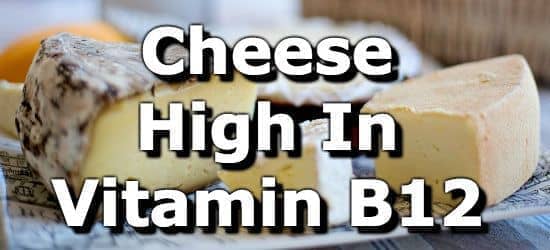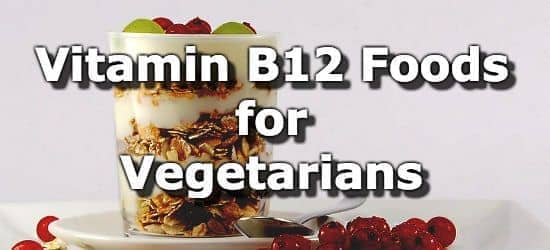Cheese High in Vitamin B12

Cheese, in addition to being a good vegetarian source of protein, is also a great natural source of vitamin B12 for vegetarians.
Below is a list of 15 types of cheese ranked by their amount of vitamin B12. Whole milk Swiss Cheese provides the most B12 with 0.9mcg (36% DV) per ounce. An ounce of cheese is equal to 28 grams or about a slice of cheese which is large enough to cover a piece of bread. Other types of cheese high in vitamin B12 include Gjetost, Mozzarella, Tilsit, Feta, and Brie.
The daily value (DV) for vitamin B12 is 2.4mcg per day. In 2016, this was reduced from 6mcg per day, because the scientific evidence shows that 2.4mcg is enough to prevent symptoms of deficiency in the majority of people. For this reason, the percentage of the daily value (%DV) may appear lower on outdated product labels. (1)
For more information, see the article on natural vegetarian sources of vitamin B12, and the complete list of dairy foods high in vitamin B12.
| Food | Serving | Vitamin B12 |
|---|---|---|
| #1 Swiss Cheese | per oz | 36% DV 0.9mcg |
| #2 Gjetost | per oz | 29% DV 0.7mcg |
| #3 Mozzarella | per oz | 27% DV 0.6mcg |
| #4 Tilsit | per oz | 25% DV 0.6mcg |
| #5 Low Fat Cottage Cheese | per 4oz (1/2 cup) | 22% DV 0.5mcg |
| #6 Feta | per oz | 20% DV 0.5mcg |
| #7 Brie | per oz | 20% DV 0.5mcg |
| #8 Gruyere | per oz | 19% DV 0.5mcg |
| #9 Gouda | per oz | 18% DV 0.4mcg |
| #10 Ricotta | per 1/2 cup | 44% DV 1.1mcg |
| #11 Provolone | per oz | 17% DV 0.4mcg |
| #12 Grated Parmesan | per oz | 17% DV 0.4mcg |
| #13 Blue Cheese | per oz | 14% DV 0.3mcg |
| #14 Romano | per oz | 13% DV 0.3mcg |
| #15 Cheddar Cheese | per oz | 13% DV 0.3mcg |
About the Data
Data for the curated food lists comes from the USDA Food Data Central Repository.
You can check our data against the USDA by clicking the (Source) link at the bottom of each food listing.
Note: When checking data please be sure the serving sizes are the same. In the rare case you find any difference, please contact us and we will fix it right away.
About Nutrient Targets
Setting targets can provide a guide to healthy eating.
Some of the most popular targets include:- Daily Value (%DV) - The daily value (%DV) is a general guideline for consumption that will prevent deficiency of a particular nutrient in most people. The %DV refers to the percentage of an amount that\'s found in a single serving of a food. It also accounts for absorption factors. It is set by the U.S. FDA.
- Recommended Dietary Allowance (%RDA) - The RDA sets an average daily dietary intake level that is sufficient to meet the nutrient requirements of nearly all (97.5%) healthy individuals. It\'s more specific than the daily value, and varies by age and gender. The RDA is set by the US National Institutes of Health.
- Reference Dietary Intake (%RDI) -The reference dietary intake is similar to the recommended daily allowance, but is specific to age and gender. The RDI for amino acids is set by the U.N. World Health Organization.
- Adequate Intake (%AI) - This value is primarily used in reference to omega-3 and omega-6 fats. The Adequate Intake is set by the U.S. Institute of Medicine. Because there is less evidence to determine the ideal targets for consumption of these nutrients, the specific amount is considered to be less reliable. Using the term Adequate Intake, rather than one of the other terms, helps to emphasize that the ideal intake of that particular nutrient has not yet been scientifically determined.
See the Guide to Recommended Daily Intakes for more information.
Want to set your own targets? Sign up for an account and set custom targets in the daily food log.From the Nutrient Ranking Tool
Use the ranking tool links below to select foods and create your own food list to share or print.
- Foods High in Vitamin B12
- Foods Low in Vitamin B12
- Vegetarian Foods High in Vitamin B12
- Dairy High in Vitamin B12
- Breakfast Cereals High in Vitamin B12
- Fast Foods High in Vitamin B12
View more nutrients with the nutrient ranking tool, or see ratios with the nutrient ratio tool.
Related
Data Sources and References
Try the recipe nutrition calculator, or daily meal planner.
Create a free account to log and track foods.


 Next ➞
Next ➞